Following the catastrophic events of World War II, Germany found itself in ruins and its once unified capital, Berlin, at the forefront of geopolitical tensions. The country’s division began at the Potsdam Conference, where the victorious Allies, the United States, the Soviet Union, the United Kingdom, and later France, agreed to split Germany into four occupation zones.
The Division of Berlin Germany was meant to facilitate the rebuilding process and denazification while serving the different geopolitical interests of the Allies. Berlin, located deep within the Soviet sector of East Germany, was also divided into four corresponding sectors, encapsulating a microcosm of the wider German partition.
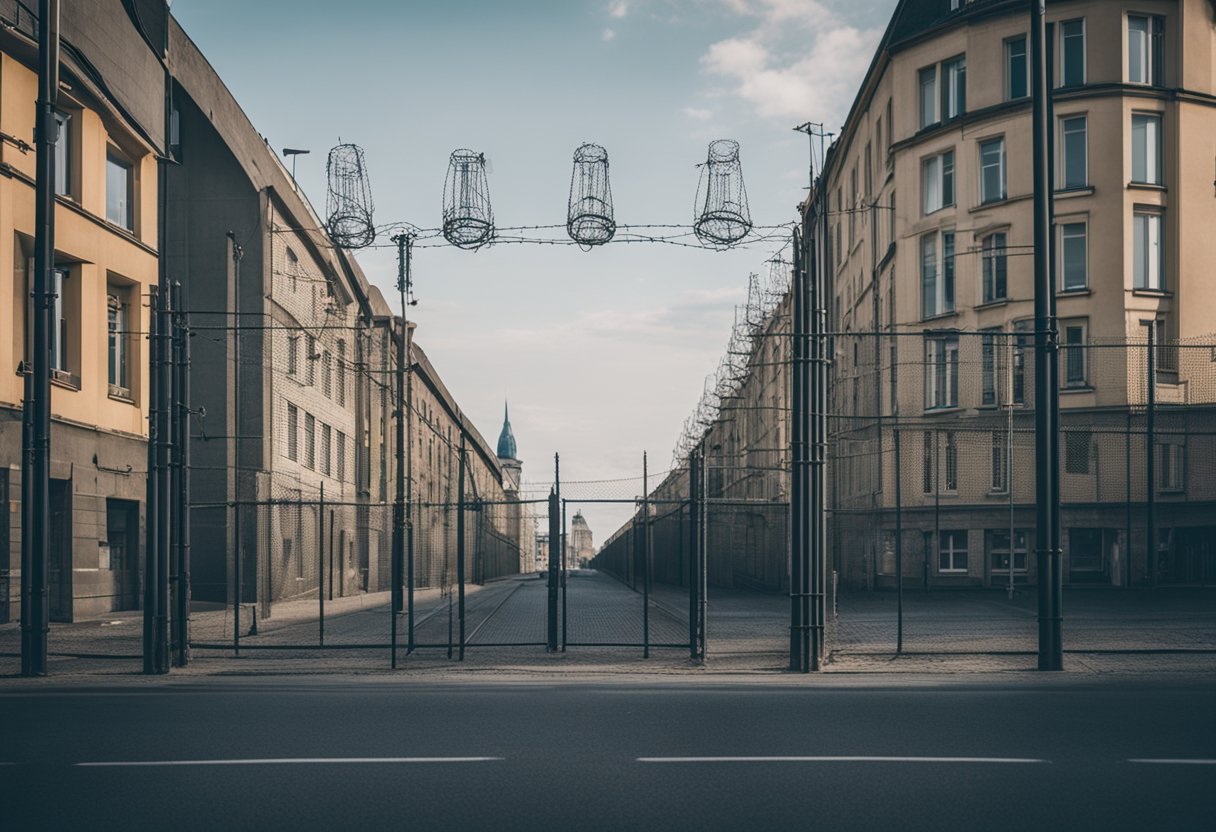
The arrangement in Berlin quickly became a focal point of Cold War friction, functioning as the embodiment of the ideological battle between the capitalist West and the communist East.
In time, the Berlin Wall, erected virtually overnight on August 13, 1961, became the physical manifestation of a city and a nation divided. It not only concretely separated East Berlin from West Berlin but also came to symbolize the “Iron Curtain” that had descended across Europe, separating the Eastern Bloc from the West.
This led to the city experiencing a unique segregation, with families, communities, and a whole metropolis cut in half for nearly three decades.
The reasons behind the partition of Berlin and Germany were manifold, encompassing a tangle of diplomatic, military, and ideological motivations.
While the rest of Germany was eventually consolidated into two separate states—the Federal Republic of Germany (West Germany) and the German Democratic Republic (East Germany)—Berlin remained a divided city within East German territory, a peculiar arrangement that echoed the broader East-West divide of the period.
It wasn’t until the dramatic events leading up to the fall of the Berlin Wall on November 9, 1989, that the city would embark on a path toward reunification, mirroring the larger German process that would culminate in October 1990.
Historical Background-The Division of Berlin Germany
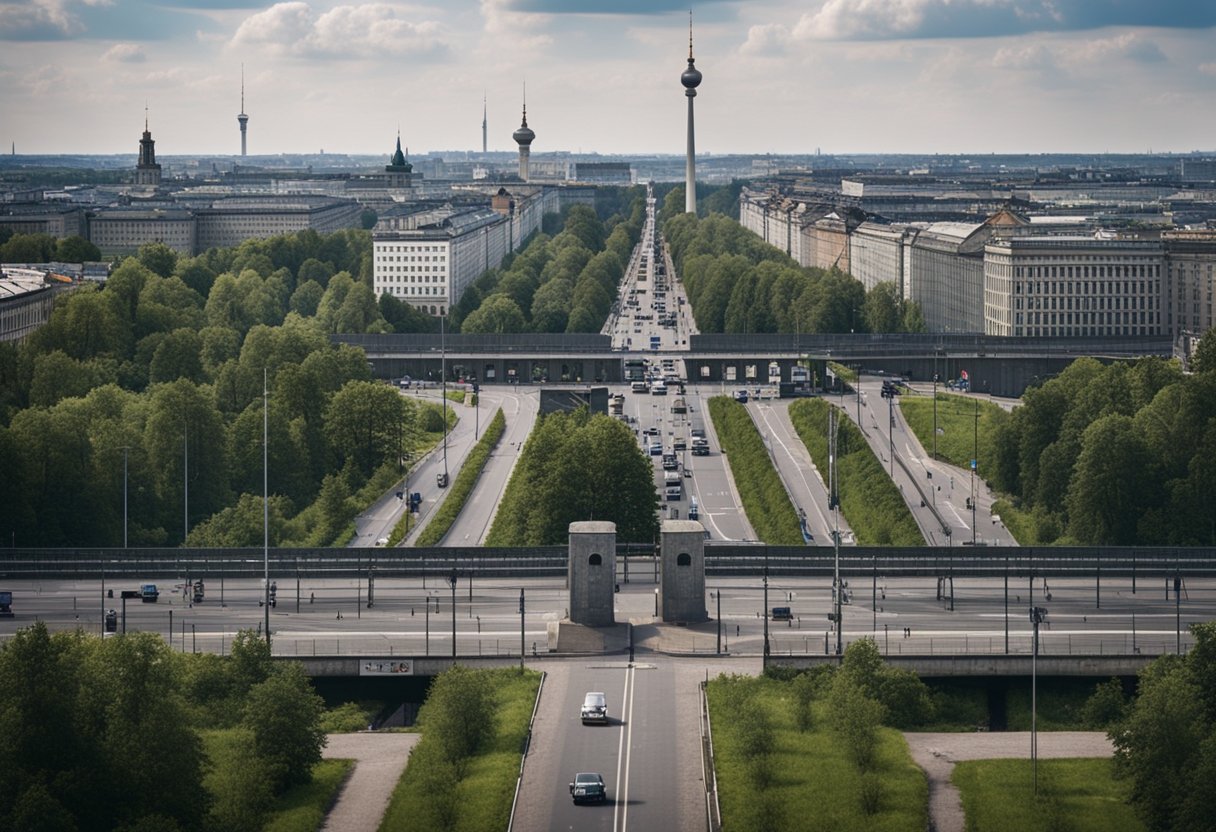
The crux of Berlin’s division traces back to the geopolitical aftermath of World War II, where decision-making by the victorious Allied powers set the stage for the city’s future segmentation.
Post-World War II Developments
Following the defeat of Nazi Germany, Allied occupation authorities entered the country to initiate the process of demilitarization and denazification. Germany was partitioned into four occupation zones controlled by the United States, Soviet Union, British, and French forces. Despite its location deep within the Soviet sector, Berlin itself was similarly divided into four segments, reflecting the city’s importance and symbolic status.
Potsdam Conference and Division Parameters
The Potsdam Conference of 1945, attended by the major allied powers, was where leaders laid down the guidelines for post-war Germany. Decisions reached here were critical in shaping both Germany’s and Berlin’s divisions.
The parameters defined the roles of the Allied Control Council and established the mechanisms through which the country would be managed. These discussions were an extension of earlier talks at the Yalta Conference and set into motion the eventual establishment of separate states.
Formation of East and West Germany
The political landscape in the occupation zones evolved rapidly, marked by the consolidation of zones and differing ideologies. By 1949, these shifts led to the formation of two distinct German states: the Federal Republic of Germany (FRG) in the West and the German Democratic Republic (GDR) in the East.
Berlin, encircled by the GDR, was a focal point of tension, culminating in the construction of the Berlin Wall in 1961. The city became the preeminent symbol of the Iron Curtain and a frontline in the Cold War. Initiatives such as the Marshall Plan further deepened the economic and ideological rift that defined the separated Germany and Berlin.
Life in Divided Berlin
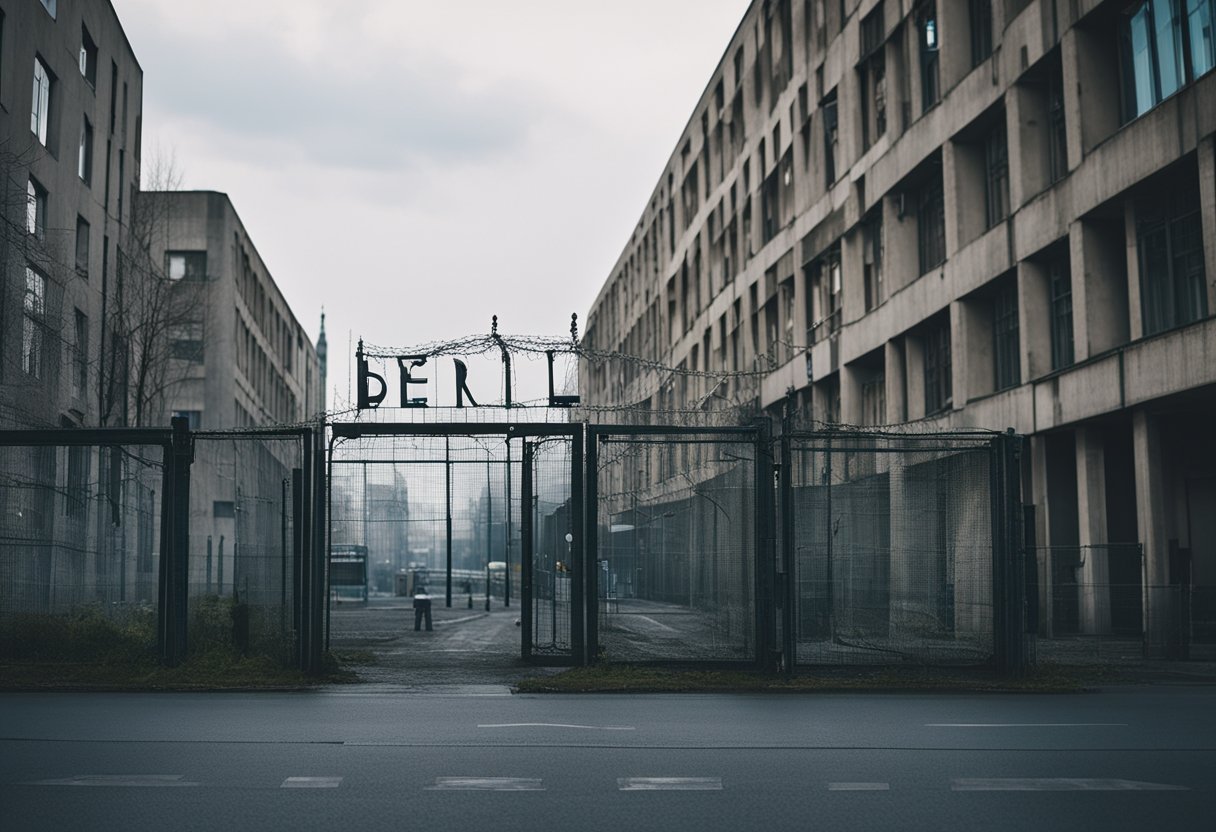
After the end of World War II, Berlin became the focal point of the Cold War tensions, split into East Berlin and West Berlin, with the former controlled by the Soviets and the latter by the Americans, British, and French. This division resulted in stark contrasts in every aspect of life within the city, from economy and government to culture and identity.
Economic Disparities and Currency Reform
The split of Berlin led to distinctive economic trajectories for East and West Berlin. The Federal Republic of Germany (West Germany) introduced the Deutsche Mark in its sectors, fostering a capitalist economy, while the German Democratic Republic (East Germany) continued with a socialist system, later introducing the East German mark in response to currency reform.
West Berliners enjoyed higher wages and greater availability of goods, contrasting markedly with economic hardship in East Berlin.
Political Systems: Democracy vs. Communism
Politically, West Berlin embedded the principles of democracy that aligned with the broader Federal Republic of Germany, fostering a society more closely mirroring the values of Western Europe.
Conversely, East Berlin operated under a communist regime as part of the German Democratic Republic, where the state had significant control over people’s lives, leading to oppression and fewer personal liberties. Renowned political figures like Willi Brandt, who was the mayor of West Berlin and later Chancellor of West Germany, were part of the narrative of defiance against the communist influence of the Soviets.
Social and Cultural Influences
Divided Berlin was more than just a city split by a wall; it was a place where two conflicting worldviews met. In the West, freedom of expression and cultural influences from the United States and Western Europe were prevalent, shaping the identity and values of its inhabitants.
East Berlin, under stricter socialist control, emphasized collective ideals and often suppressed Western cultural imports that might undermine its ideology. Despite the Berlin Wall symbolizing this division, cultural exchanges and the movement of refugees between the two sides showcased the human desire to seek better living conditions and freedom.
The Berlin Wall
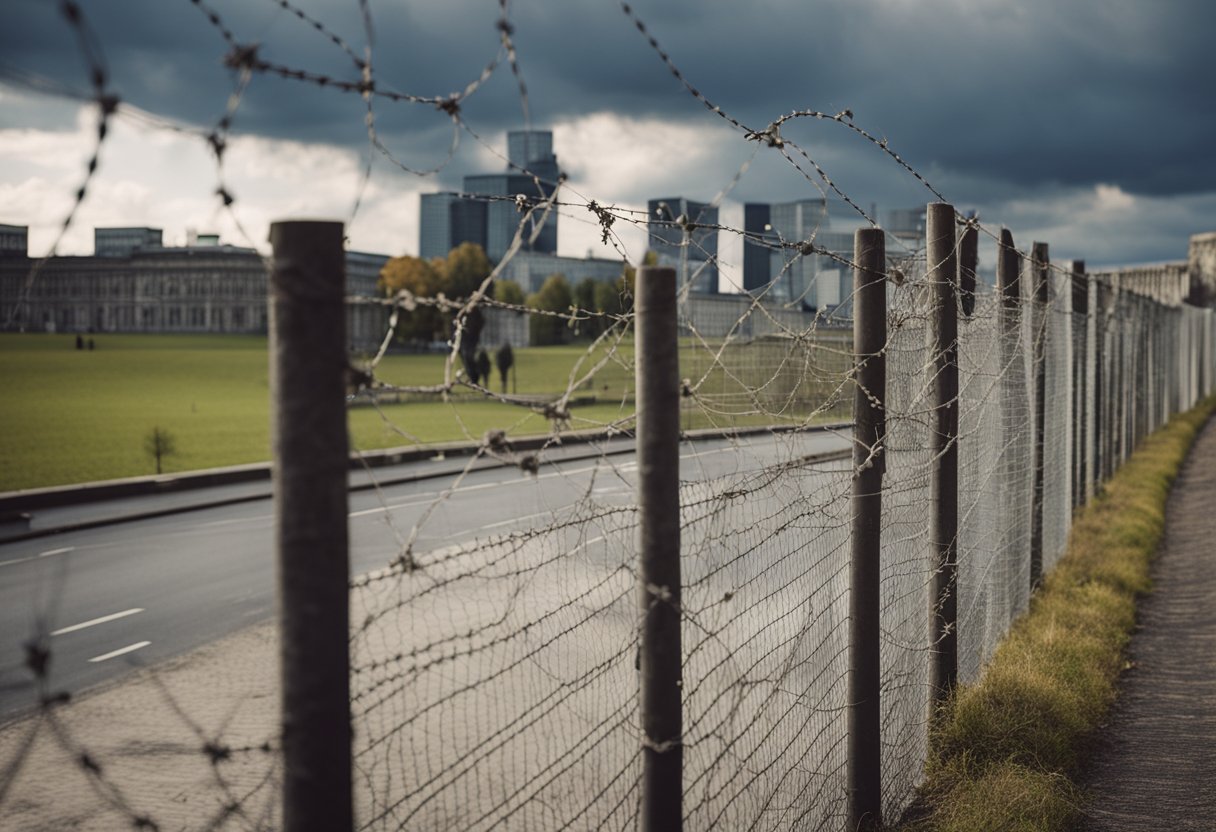
The Berlin Wall stands as a stark symbol of the Cold War division of Germany into East and West, ultimately splitting the city of Berlin itself. Erected by the German Democratic Republic (GDR), it became the physical manifestation of the Iron Curtain.
Erection of the Berlin Wall
August 13, 1961, marked the chilling dawn of the Berlin Wall’s construction. Initially a barbed wire barricade, it evolved into a formidable concrete structure, designed to prevent East Germans from defecting to the West. The wall stretched over 155 kilometers encircling West Berlin, effectively isolating it from the surrounding East German territory.
- Materials Used:
- Concrete blocks
- Barbed wire
- Anti-vehicle trenches
Impact on East and West Berliners
For the residents of East and West Berlin, the wall represented a painful and tangible divide. Families were torn apart, and East Berliners were cut off from the economic prosperity experienced in the West. The wall became a canvas expressing the frustration and longing for freedom through graffiti.
- Consequences for Residents:
- Separated families
- Restricted freedom of movement
- Economic disparity
Escapes and the Stasi
Desperation led to dramatic escape attempts over, under, and through the Berlin Wall. East German secret police, known as the Stasi, tightly monitored these efforts, leading to tragic outcomes for many would-be escapees. The escapes added to the tension of the Cold War, and the Stasi further ensured the suppressive control over East Germans.
- Notable Elements:
- The Berlin Wall Trail, tracing the path of the former barrier
- Guard towers and bunkers along the border
- Victims of the Berlin Wall estimated at over 140 people
The Berlin Wall, both an oppressive tool for the East German government and a powerful emblem of the yearning for freedom, remained a potent symbol of division until its fall in 1989.
Geopolitical Dynamics
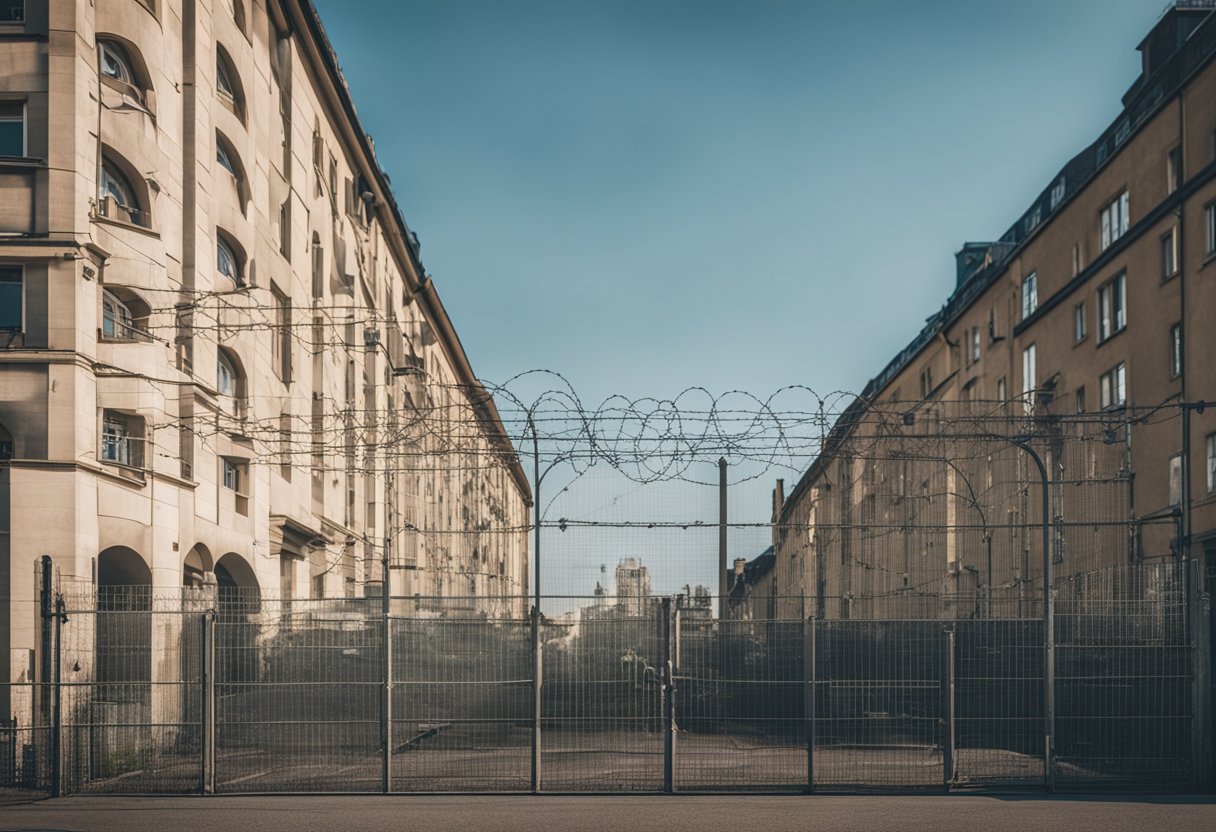
The division of Berlin was a complex interplay of geopolitical tensions and agreements among wartime Allies, setting the stage for a divided city in a divided nation.
The Cold War and Berlin
The Cold War was the backdrop against which Berlin was carved into segments. The city became the focal point of global tension between the United States and the Soviet Union. The division of Berlin materialized physically with the construction of the Berlin Wall, making it the epicenter of the ideological duel between capitalism and communism.
The Allied Powers and Occupation Zones
Following Germany’s surrender in World War II, the Allied powers—the United States, Britain, France, and the Soviet Union—implemented the four-power agreement. They decided to divide Germany into four occupation zones, each controlled by one of the Allies.
Berlin, located deep within the Soviet zone, was similarly split, albeit a special enclave where all four powers had authority—ostensibly facilitating a joint administration but leading to significant frictions.
International Relations and Diplomacy
International relations during this era were marked by the complexities of post-war diplomacy, with Germany and Berlin embodying these challenges.
The Berlin Airlift of 1948-1949 underscored the Allies’ commitment to sustain West Berlin amidst a Soviet blockade, a strategic triumph of airpower over land blockade. This airlift epitomized the determination to counteract Soviet expansion and maintain Western presence in Berlin.
Path to Reunification

The journey towards reunification of Germany is marked by significant events including the decline of Soviet control, the fall of the Berlin Wall, and the formal process that led to the unified Germany we know today.
Decline of the Soviet Influence
The waning of the Soviet Union’s grip on Central Europe accelerated the possibility of German reunification. By the late 1980s, the wave of democratization began to sweep across the Eastern bloc, weakening the communist stronghold and increasing calls for freedom in East Germany.
The Fall of the Berlin Wall
November 9, 1989, marks a pivotal moment with the unexpected fall of the Berlin Wall. Initiated by a mistaken announcement allowing unrestricted passage between East and West, crowds surged to the Wall, dismantling it piece by piece, a symbolic end to decades of separation.
German Reunification
Under the leadership of Chancellor Helmut Kohl, East and West Germany moved swiftly towards unification. After economic and political adjustments, formal reunification was celebrated on October 3, 1990, when Germany was officially declared a single nation, with Berlin reinstated as its capital.
Legacy and Memory
The division of Berlin, and by extension Germany, created profound effects on the cultural memory and collective consciousness of Germans. These impacts are memorialized, taught, and reflected upon in various ways, influencing modern perspectives on democracy, freedom, and the lessons learned from the past.
Remembrance and Memorials
Berlin’s landscape is marked by numerous memorials acknowledging the complex history of the city’s division. The remnants of the Berlin Wall, now a symbol of the Cold War, serve not only as a physical reminder but also as a testament to the resilience of Berliners and the desire for unity.
Sites such as the Berlin Wall Memorial and Checkpoint Charlie have become places where both Germans and visitors from around the world can reflect on the stark contrasts between a city once divided by a physical barrier and ideologies. These memorials also pay respect to the struggles of those who were once classified as refugees, attempting to flee the suppressive conditions of the Soviet Union-controlled East Germany.
Historical Significance and Education
Education programs across Germany provide detailed accounts of the country’s divided past. The history of post-war Germany, particularly the roles of the Allied Kommandatura, the Nuremberg trials of war criminals, and the subsequent establishment of a democratic framework in West Germany, is extensively covered in both school curricula and public discourse.
Teaching about the division of Berlin, located deep within East Germany, underscores the complexities of the city’s geopolitical situation and why it was a focal point of Cold War tension.
Modern Perspectives on Division
Today, reflections on the divided Berlin and broader Germany often center on how such historic divisions continue to shape the climate of contemporary German politics and society. Despite reunification, there are still discussions about the social and economic disparities that can be traced back to the split between East and West.
Berlin, once the epicenter of Cold War division, now symbolizes a successful democracy and unity, but it also is a point of reference for ongoing debates about freedoms, governance, and maintaining the lessons learned from its histories to prevent future divides.
Frequently Asked Questions
Berlin’s division after World War II into various sectors, the creation of the Berlin Wall, its eventual fall, and the reunification of Germany are pivotal events in modern history. These not only shaped the city’s fate but also reflected global Cold War tensions.
Why was Berlin split into different sectors after World War II?
Berlin was split into different sectors after World War II as a result of the Allied powers’ decision to divide control of Germany’s capital. This was intended as a temporary measure to facilitate post-war reconstruction and denazification.
What were the names of the sectors into which Berlin was divided?
The sectors into which Berlin was divided were known as the American, British, French, and Soviet sectors. Each ally controlled a separate sector, which reflected their sphere of influence over different parts of the city.
For what reasons was the Berlin Wall constructed?
The Berlin Wall was constructed to prevent East Germans from fleeing to the West. It solidified the separation between the Soviet-controlled East Berlin and the Western sectors, symbolizing the ideological divide between communism and democracy.
How did the geopolitical landscape of Berlin change after the erection of the Berlin Wall?
The geopolitical landscape of Berlin became more rigid after the erection of the Berlin Wall, with the city turning into a focal point for Cold War tensions. The wall served as a physical and ideological barrier between the two sides.
What events led to the fall of the Berlin Wall?
A combination of political upheavals, economic struggles, and increased emigration pressures in Eastern Europe culminated in the fall of the Berlin Wall. Key events included reform movements in the Soviet Union and other Eastern Bloc countries leading to a shift in East German policies.
How did the division of Berlin symbolize the broader East-West conflict during the Cold War?
The division of Berlin was a stark illustration of the broader East-West conflict during the Cold War. Each sector of Berlin, and the wall that split it, stood as emblems of the ideological struggle between capitalist and communist forces on a global stage.